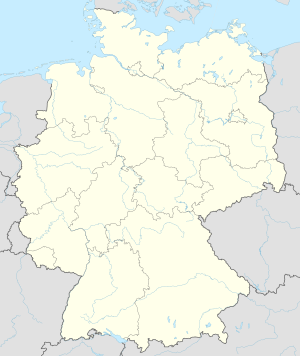Bremen railway bridge
Coordinates: 53 ° 4 ′ 50 ″ N , 8 ° 47 ′ 20 ″ E
| Railway bridge | ||
|---|---|---|
|
Bremen railway bridge with the Weser district in the background |
||
| use | Railway bridge | |
| Convicted | Bremen – Oldenburg railway line | |
| Crossing of |
Weser near Unterweser - km 1.375 |
|
| place | Bremen | |
| construction | Truss bridge made of steel | |
| overall length | 216 m | |
| Number of openings | 4th | |
| opening | 1962 | |
| location | ||
|
|
||
The railway bridge over the Weser on the northwestern edge of Bremen city center is actually nameless. It is the only railway bridge over the Weser that has always stood entirely on Bremen territory and the only one in the Bremen city area that - for over half a century - was the property of the Bremen state .
Since its construction, it has been the northernmost bridge over the main river of the Weser.
Today's bridge is the second at this point and is 216 m long. She has four yokes of which form the two long the actual current bridge and a box bridge steel truss are executed. The middle pillar stands on a mole that is an island along the Weser and divides the river asymmetrically.
The Bremen railway bridge over the Weser

The first bridge was built by the Free Hanseatic City of Bremen in 1866/1867 after the Grand Duchy of Oldenburg and Bremen had reached an agreement on March 8, 1864 on the construction of the Bremen – Oldenburg railway line . During the project phase, the plans were fundamentally changed in two respects: Originally, a single-track bridge with a looping track in both directions and rotating yokes for shipping traffic on both sides of the river were planned. The construction came from the machine factory of Waltjen & Leonhardt . The bridge was built with two tracks, despite the initially low train traffic, and there was only a rotating yoke on the old town side. Between the Drehjoch and the embankment to the right of the Weser there was a short yoke in the bank area. In addition to the rotating yoke, the actual current bridge also comprised three other yokes. All yokes were designed as lattice bridges with an arched longitudinal section.
Along with the bridge built Bremen the railway line from the port of Weser railway to the state railway station to Bahnhof Bremen-Neustadt and remained until the founding of the Deutsche Reichsbahn owned. The rail traffic between Bremen and Oldenburg was the responsibility of the Grand Ducal Oldenburg State Railways . Inside Bremen, the bridge served as a rail link to the Hohentorshafen .
Thirty years after it was put into operation, the bridge was strengthened and the rotating yoke was moved so that it had been above the middle of the Weser since 1897.
Destruction from war and ice
During the Second World War , the bridge was so badly destroyed by bombs on March 23, 1945 that train traffic was no longer possible. But already at the beginning of April a boardwalk for pedestrians was set up on the preserved girders. The reopening for rail traffic was only possible on December 9, 1946. Just three months later, on March 18, 1947, the bridge collapsed due to the ice drift during the Bremen ice disaster . A week later, a pedestrian walkway was built next to the bridge and on April 26th, trains were again able to cross the temporarily repaired bridge.
Today's bridge
To remedy the temporary solution, a new one was built upstream next to the old bridge from March 1960 to July 31, 1961. On September 12, 1961, it was put into operation on a single track. Now the old bridge could be removed. On February 4, 1962, the new bridge was placed in its final position. Rail traffic has been rolling over the bridge in two tracks since May 24, 1962.
Probably since the repairs in 1946 and 1947, but at the latest since 1960, the railway bridge forms the upper limit of shipping on the Weser .
proof
- ↑ Harald Goergens and Alfred Löhr: Pictures for all. Bremer Photography in the 19th Century , Focke-Museum Bremen, 1985, p. 78f., With illustrations of two (of seven) photos
literature
- Herbert Black Forest : The Great Bremen Lexicon . Volume 1: A-K. 2nd, updated, revised and expanded edition. Edition Temmen, Bremen 2003, ISBN 3-86108-693-X .
- Hartmut Roder (Ed.): Traffic in Bremen . Steintorverlag, Bremen 1988, ISBN 3-926028-15-7 .
Web links
- Journal of the Architects and Engineers Association in Hanover, Vol. XV 1869, Issue 1–4, pp. 215 ff., Drawings on pages 438 to 446. Description of the foundation and the iron superstructure of the bridge over the Great Weser in Bremen in the Bremen-Oldenburger Eisenbahn (PDF) : very detailed description of the project development in technical and political terms


